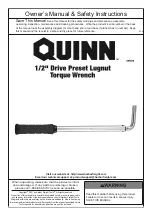
28
6.43
The saw chain must be lubricated at all times.
Before starting work find a clear area, run the chainsaw at medium power and visually
check for oil scatter.
6.44
The chain oil flow can be altered by inserting a screwdriver into the adjustment screw
on the underside of the chainsaw and adjusting the oil flow accordingly to your work
conditions.
6.43
Never operate the chainsaw at an angle greater than 60°. This will reduce the risk of
being struck by falling objects during operation.
6.44
Maintain a clearance of at least 15m between the chainsaw and any electrical line.
6.45
Ensure the work area is cleared before operation. Remove any debris that could
cause an obstruction if you need to make a quick exit from falling branches.
6.46
Remove any dead branches or other obstructions that may unexpectedly fall when
using the chainsaw.
6.47
Start from the lowest point and work up, this prevents cut branches becoming entangled
and causing a hazard.
6.48
Only work in suitable conditions and avoid high winds.
6.49
To remove a branch from a tree ‘delimbing’ cut the branch in to manageable sections
rather than removing the entire branch in one go.
6.50
Let the chainsaw do the cutting, do not force the chain through.
6.51
Run the chainsaw up to full speed and make a relief cut approximately one third of the
way through the bottom of the branch using the top of the guide bar.
6.52
Cut the final two thirds of the branch from the top of the branch.
Kickback
6.53
Kickback may occur when the nose or tip of the guide bar touches an object or when
the wood closes in or pinches the saw chain in the cut.
Tip contacting some cases, may cause a lightning fast reverse reaction, kicking the
guide bar up and back towards the operator.
CHAINSAW
















































